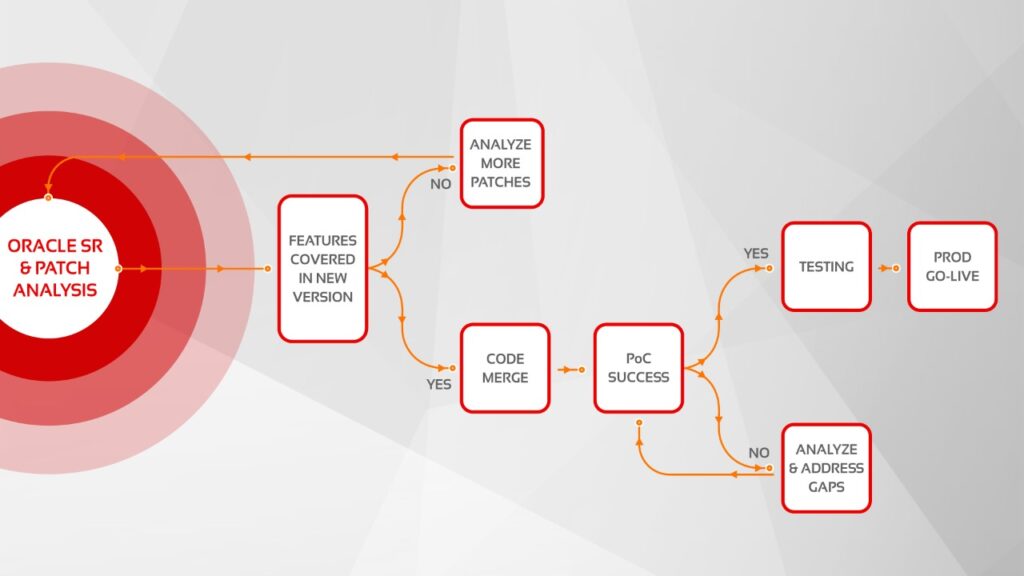It is very critical and essential to keep the IT systems and products up to date, especially because data security theft can happen at any time. It is the fundamental necessity for any company to maintain the equilibrium of technologies and feature changes to sustain their organization in the competitive world.
In adjusting to the modern technologies and competition, Oracle has upgraded its Billing and Revenue Management (BRM) product. With Oracle BRM Upgrade, the new product version will stay compliant with Oracle licenses in the future and it’ll improve the stability of the product. Keep in mind that the upgraded version will enhance the product features for creating new revenue monetization streams and will modernize the current overall architecture. It is a routine phenomenon where Oracle releases patches to fix the technical, functional, and to overcome performance issues of their products.
Here in this article, we will cover the basic process of performing Oracle BRM Upgrade in a live system with near-zero downtime. Just follow the brief for any BRM upgrade projects.
What is Oracle BRM Upgrade mean?
Upgrading any products or system means, creating convenience and providing a better customer experience. With Oracle BRM Upgrade, the system is not only updated to keep the license terms and get product support from Oracle , but it is refurbished to the latest versions with new features and supports the business stakeholders. The technological updates and the new features in the product will help the business teams to track the popular BRM system features. Hence, it helps the business teams to serve their customers better.
Purpose of upgrading a system?
Upgradation of system is a continuous phenomenon. Businesses wants to customize the product as per their requirements and in the process the complexity in upgrading the system increases. It is challenging to upgrade any billing system as per the unique requirements of businesses and industries and Oracle BRM Upgrade is not an exception. It is time consuming to create a provision to customize the product according to the business needs and hence it complicates the product upgrade.
To upgrade your system with near-zero downtime
Remember, Oracle BRM Upgrade exercise will vary from system to system and customer to customer. Before you start the upgrading process of the system, choose the exact target version and the patch of the BRM system, which is most important. The target BRM version and patches could vary depending on the exact business requirement and the roadmap of the company. The pictorial representation below will show you the basic activities involved in the Oracle BRM Upgrade project.
1. Oracle SR & Patch Analysis
While performing the system upgrade, analyze Oracle Support Requests (SR) for the current BRM system. Analyzing the SR is the very basic activity because some of the SR solutions might already have been covered in previous versions or specific patches of the BRM release.
2. Feature Analysis & Comparison
Second priority is to feature mapping of the existing BRM system with the target version and the patch selected for the upgrade. Some of the features might have been continued in the latest versions and patches also. And, the customization features might become the standard features in the upgraded version. Also, if the customization feature is not covered in the upgraded version or patch then, the current customization should continue. Hence, if there’s any feature deviations from Oracle, a Support Request would help you get a proper resolution.
3. Code Merge
Take the baseline code from any fresh installation of the target version. Merge the customized policy opcodes & custom facility module codes to the baseline code to create the target deployment package.
4. Proof of Concept
Try to bring up the system after deploying the deployment package in the latest version of the BRM system. Confirm the deployment package once the system is up and running or fix the deployment package until the system becomes normal and stable.
5. Testing
Once the Oracle BRM Upgrade is done to the latest version, fix any issues with an end-to-end testing activity. It could be functional, performance, or regression. Depending on the issue’s weightage, the Oracle team can help you with a direct code fix or any other issues.
6. Production Go-Live
Plan a Production Go-Live following the successful testing activities. Be ready with a parallel DB server with the production data for achieving near-zero downtime during the Go-Live process.
After the DB server is equipped, get the advantage of Oracle Golden Gate (GG) to sync the data between the existing and new DB server. Now, for the time being, break the replication when the GG lag is zero. Complete the upgrade in the new DB server. After the upgrade, initiate the GG replication again in upgrade mode to sync the data from the old version to the new version of BRM DB.
Now, route the traffic from the old server to the new server on the exact Go-Live date. It is how the lower version of Oracle BRM Upgrade is done to the latest version with the overall performance and stability.
[WPSM_AC id=3561]
As an Oracle Gold Partner, Aarav Solutions have delivered successfully multiple Oracle BRM implementations and upgrade projects for the leading global Communication Service Providers across Asia pacific, Middle East and USA. For Oracle BRM we provide services such as customization’s, integration, optimization, migration, support, deployment and upgradation. If you have any query related to oracle brm implementation or how we can help you with our expertise, make sure to contact us at connect@aaravsolutions.com.







